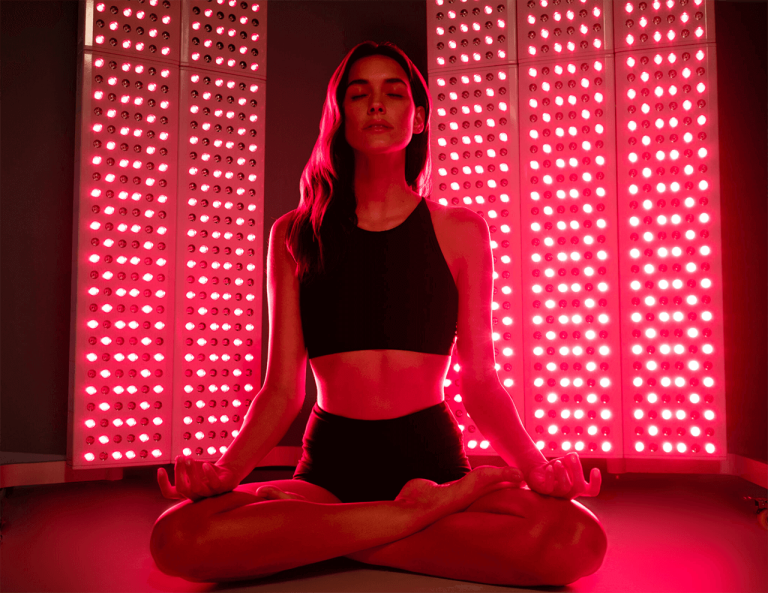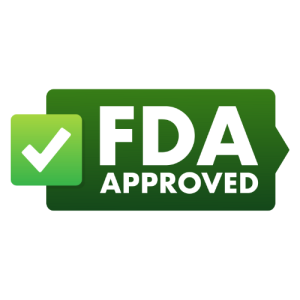
What is Red Light Therapy?
Red Light Therapy (RLT), also known as Low Level Laser Therapy (LLLT), Low Power Laser Therapy (LPLT) and Photobiomodulation (PBM), is a treatment that utilizes specific wavelengths of red and infrared light to penetrate the skin and reach the mitochondria within the cells to enhance mitochondrial function to rejuvenate the cells.
How does Red Light Therapy work?
It’s well-known that the human body needs sunlight which is a combination of the entire visible light spectrum (400-700 nm) as well as UV (10-400 nm), near-infrared (700-1000 nm), and far infrared wavelengths (1000-3000 nm).
Scientists have also discovered that our cells have an incredible response to light in the 600-900 nm wavelength range. This light can pass through human tissue much easier than other wavelengths. Specifically, the light at about 660 nm and 850 nm has been shown to provide an ideal biological response.
Red light therapy uses low-power red and infrared light to activate the cell’s energy generators – the mitochondria. This in turn promotes the production of ATP (adenosine triphosphate). More ATP means more energy for your cells, promoting cell vitality and repair, which helps skin, muscle tissue, and other parts of your body heal and perform better.
The Benefis of Red Light Therapy
What skin conditions are red light therapy for?
Red light therapy is promoted as a treatment for some common skin conditions, including:
Improving wound healing.
Reducing stretch marks
Reducing wrinkles, fine lines, and age spots.
Improving facial texture.
Improving psoriasis, rosacea, and eczema.
Improving scarring.
Improving sun-damaged skin.
Improving hair growth in people with androgenetic alopecia.
Improving acne.
Is red light therapy effective?
Most experts say they don’t yet know if Red Light Therapy really works for all the uses it claims. Most say that studies published so far show some potential for some conditions, but more research is needed. Red light therapy is still an emerging treatment that’s getting more and more attention. But there’s not enough evidence to support most uses.
The gold standard for research to determine if a product works is a randomized, placebo-controlled trial. That means a certain number of people with the same characteristics (age, weight, race, sex, etc.) receive either the study treatment or a placebo (a fake or “sham” treatment) to treat the same condition.
Some studies also include a comparison with another commonly used treatment. The new treatment can then be compared to the results of no treatment (placebo group) or the “current standard” treatment.
Many of the published studies using Red Light Therapy included only a small number of people, did not include a placebo group, were not conducted on humans (animal studies) or were limited to cell tissue itself. Most researchers say that the results so far look promising, but more and better quality studies with larger numbers of people are needed.
Is Red Light Therapy Safe?
Red light therapy appears to be safe and does not cause any side effects, at least when used as directed in the short term. The treatment is non-toxic, non-invasive, and not as irritating as some topical skin treatments. Unlike cancer-causing ultraviolet (UV) light emitted by the sun or tanning booths, Red Light Therapy does not use this type of light.
However, if the product is used incorrectly—perhaps too often or not as directed—your skin or eyes (if unprotected) could be damaged. The long-term safety of devices that use red light therapy is unknown.
Your safest bet is to see a dermatologist or qualified, trained beauty therapist. A dermatologist can make sure your skin is what you expect it to be and can discuss the merits of red light therapy versus other treatment options.
Is purchasing a device for home use a safe, reasonable option?
Yes, you can purchase Red Light Therapy Devices. If you do choose to purchase a Red Light Therapy device, be sure to protect your eyes, follow all instructions, and take good care of the device.
In addition to use in medical offices and purchasing devices for home use, you may also see Red Light Therapy promoted by beauty salons and spas, saunas, tanning salons, gyms, and wellness centers.
What other conditions are Red Light Therapy used for?
Other potential medical uses being studied include:
Relieving the side effects of cancer chemotherapy, including oral mucositis.
Relieving pain and inflammation associated with ankle tendinitis, rheumatoid arthritis, carpal tunnel syndrome, and knee osteoarthritis.
Preventing recurrences of cold sores caused by the herpes simplex virus.
There are many other uses on the Internet. There is no scientific evidence to support the use of Red Light Therapy for weight loss, cancer, removing cellulite, or treating mental health issues such as depression and seasonal affective disorder (SAD).
FAQs
1.What should I wear during red light therapy?
You can remove clothing to a comfortable level, as red and infrared wavelengths are best absorbed by increased skin exposure.
2.What should I do to prepare before red light therapy?
Moisturizing is key. Stay hydrated and drink enough water before, during and after treatment.
3.Can children use red light therapy?
Can be used by children. However, children generally have a higher metabolic rate than adults, so their core body temperature rises much faster than adults. Therefore, children’s heart endurance and self-regulation ability may not be able to adapt to higher temperatures. Therefore, we recommend that when you are with children, be careful not to overheat the temperature and do not exceed 15 minutes at a time. And must be accompanied by an adult. At the same time, even if the child is not sweating, he should replenish water in time.
4.Can I take a shower after use Phototherapy Chamber?
Generally, you cannot shower immediately because the capillaries of the human body’s skin are in a state of expansion. Taking a shower at this time may cause the capillaries to shrink immediately, which is not conducive to perspiration and heat dissipation. Usually, after 4 to 6 hours, the sweat on the surface of the body gradually evaporates, and the skin condition gradually returns to normal. You can shower at this time, but everyone’s physique, experience time, etc. are different, so the specific shower time varies from person to person. The water temperature during showering should generally not be too low to avoid catching a cold and causing a cold.
5.How often should you use Phototherapy Chamber?
Red light therapy usually lasts 20 to 30 minutes each time., 3-5 times a week.
6.Are there side effects of red light therapy?
Red light therapy is a safe treatment, but there are some common-sense warnings: Wear eye protection and protect your eyes. Long-term exposure to red light can cause damage to your eyes.
Red light therapy has few side effects, but there are certain situations where it is best to avoid this treatment:
Welcome to Healing Labs, where medical innovation meets cutting-edge science. Our advanced solutions target post-surgical recovery, mental health, diabetic injuries, radiation-related illnesses, sports injuries, and age-related conditions, helping you heal faster and live stronger.
Contact
support@healinglabs.com
Toll Free:
888-974-5227
888-97HLABS
1936 Bruce B Downs Blvd UNIT #346, Wesley Chapel, FL 33544

© 2025 Healing Labs.